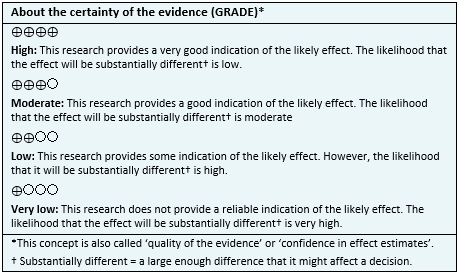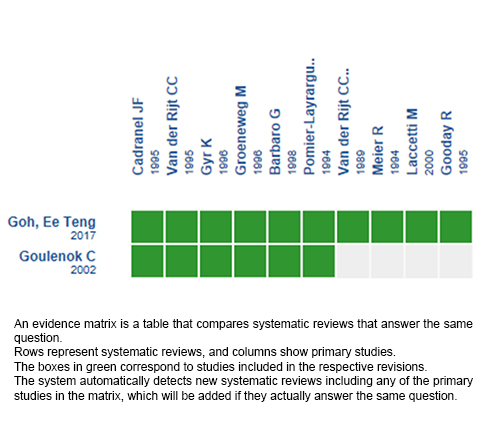Resúmenes Epistemonikos
← vista completaPublicado el 26 de diciembre de 2017 | http://doi.org/10.5867/medwave.2017.09.7113
¿Es flumazenil una alternativa para el tratamiento de la encefalopatía hepática?
Is flumazenil an alternative for the treatment of hepatic encephalopathy?
Abstract
INTRODUCTION Flumazenil is an antagonist of the GABA/benzodiazepines receptor complex that might play a role in the treatment of hepatic encephalopathy. However, its efficacy and safety are a matter of debate.
METHODS To answer this question we used Epistemonikos, the largest database of systematic reviews in health, which is maintained by screening multiple information sources, including MEDLINE, EMBASE, Cochrane, among others. We extracted data from the systematic reviews, reanalyzed data of primary studies, conducted a meta-analysis and generated a summary of findings table using the GRADE approach.
RESULTS AND CONCLUSIONS We identified two systematic reviews including fourteen randomized trials. We concluded flumazenil does not reduce mortality in patients with hepatic encephalopathy and it is not clear whether it leads to any clinical improvement because the certainty of the evidence is very low.
Problem
Hepatic encephalopathy is one of the most frequent complications of chronic liver disease [1]. Among multiple mechanisms to explain its causes, the role of sensorineural pathways involving GABA receptors has been proposed. For this reason, the use of an antagonist of the GABA/benzodiazepine receptor complex, flumazenil, has been posed as an alternative for this complication. However, some gastrointestinal, cardiac and neurological adverse effects have been described with the use of this intervention and it is not clear what is its real efficacy and safety in the management of hepatic encephalopathy.
Methods
To answer the question, we used Epistemonikos, the largest database of systematic reviews in health, which is maintained by screening multiple information sources, including MEDLINE, EMBASE, Cochrane, among others, to identify systematic reviews and their included primary studies. We extracted data from the identified reviews and reanalyzed data from primary studies included in those reviews. With this information, we generated a structured summary denominated FRISBEE (Friendly Summary of Body of Evidence using Epistemonikos) using a pre-established format, which includes key messages, a summary of the body of evidence (presented as an evidence matrix in Epistemonikos), meta-analysis of the total of studies when it is possible, a summary of findings table following the GRADE approach and a table of other considerations for decision-making.
|
Key messages
|
About the body of evidence for this question
|
What is the evidence. |
We found two systematics reviews [2],[3] including fourteen primary studies reported in 25 references [4],[5],[6],[7],[8], |
|
What types of patients were included* |
All of the trials included patients with liver cirrhosis [4],[8], Six trials evaluated patients with acute hepatic encephalopathy [11],[17],[21],[24],[27],[28] and in two trials patients with chronic hepatic encephalopathy [4],[22]. In the rest of the trials [8],[14],[19],[23],[25],[26] the timing of hepatic encephalopathy was not specified. In relation to the severity of hepatic encephalopathy, four trials included patients with minimal hepatic encephalopathy [14],[19],[23],[25], two with grade I hepatic encephalopathy [4],[25], four with grade II [4],[11],[25],[26], nine with grade III [4],[11],[17],[22],[24],[25],[26],[27],[28] and six with grade IV [11],[17],[21],[24],[26],[28]. In addition, patients with abnormal trunk evoked potentials were included in one trial [14], impaired visual evoked potentials in one trial [19], abnormal electroencephalography in two trials [8],[27], abnormal Number Connection Test in two trials [14],[19], abnormal Digit Symbol Substitution Test in one trial [23] and ammonium levels over 30 µmol/L in one trial [8]. |
|
What types of interventions were included* |
Flumazenil was used intravenously in all of the trials. In two [17],[21] it was used with 20 cc of saline solution, in one [24] with 50 cc of saline solution and in one [26] with 19 cc of saline solution. Regarding dosification, the most frequent was 1 mg single dose in five trials [11],[17],[19],[22],[26] and 2 mg single dose in three trials [4],[21],[24]. The rest of the trials used 6.5 mg per day for three days and 1 mg in a fourth day, with a total of 20.5 mg in a first part and 1 mg in 10 minutes in a second part [8], 1 mg/hour for five hours with a total of 5 mg [25], 0.2 mg once [23], 0.2 mg/kg once [27], 0.5 mg and subsequently 1 mg in 30 minutes [28] and 1 mg of loading together with 0.5 mg every 30 minutes until completing 3 mg [14]. Continuous intravenous infusion was used in four trials [4],[8],[25],[28]. In three trials [4],[8],[28] intravenous loading doses were used. One of them [8], used 0.5 mg in the first part and 1 mg in the second part of the intervention. Another trial [4], used three sequential boluses of 0.4, 0.8 and 1 mg in one minute, each prior to the use of continuous infusion. The last trial [28] used an intravenous bolus of 0.5 mg. In the remaining ten trials [11],[14],[17],[19],[21],[22],[23],[24],[26],[27] intravenous infusion was used in bolus. All the trials compared against placebo. |
|
What types of outcomes |
The main outcomes according to the systematics reviews were:
|
* The information about primary studies is extracted from the systematic reviews identified, unless otherwise specified.
Summary of Findings
The information on the effects of flumazenil in hepatic encephalopathy is based on eleven randomized trials [4],[8],[11],[17],[21],[22],[23],[24],[25],[26],[28] including 872 patients. The rest of the trials did not report the outcomes of interest, or none of the identified reviews could extract the data so they could be incorporated into a meta-analysis.
Nine trials measured the outcome hepatic encephalopathy [4],[8],[11],[17],[21],[24],[25],[26],[28] and eleven trials reported mortality [4],[8],[11],[17],[21],[22],[23],[24],[25],[26],[28].
The summary of findings is the following:
- It is not clear whether flumazenil improves hepatic encephalopathy, because the certainty of the evidence is very low.
- Flumazenil does not reduce mortality in patients with hepatic encephalopathy. The certainty of the evidence is high.


Other considerations for decision-making
|
To whom this evidence does and does not apply |
|
| About the outcomes included in this summary |
|
| Balance between benefits and risks, and certainty of the evidence |
|
| Resource considerations |
|
| What would patients and their doctors think about this intervention |
|
|
Differences between this summary and other sources |
|
| Could this evidence change in the future? |
|
How we conducted this summary
Using automated and collaborative means, we compiled all the relevant evidence for the question of interest and we present it as a matrix of evidence.

Follow the link to access the interactive version: Flumazenil for hepatic encephalopathy
Notes
The upper portion of the matrix of evidence will display a warning of “new evidence” if new systematic reviews are published after the publication of this summary. Even though the project considers the periodical update of these summaries, users are invited to comment in Medwave or to contact the authors through email if they find new evidence and the summary should be updated earlier.
After creating an account in Epistemonikos, users will be able to save the matrixes and to receive automated notifications any time new evidence potentially relevant for the question appears.
This article is part of the Epistemonikos Evidence Synthesis project. It is elaborated with a pre-established methodology, following rigorous methodological standards and internal peer review process. Each of these articles corresponds to a summary, denominated FRISBEE (Friendly Summary of Body of Evidence using Epistemonikos), whose main objective is to synthesize the body of evidence for a specific question, with a friendly format to clinical professionals. Its main resources are based on the evidence matrix of Epistemonikos and analysis of results using GRADE methodology. Further details of the methods for developing this FRISBEE are described here (http://dx.doi.org/10.5867/medwave.2014.06.5997)
Epistemonikos foundation is a non-for-profit organization aiming to bring information closer to health decision-makers with technology. Its main development is Epistemonikos database (www.epistemonikos.org).
Potential conflicts of interest
The authors do not have relevant interests to declare.

